Identifying Similar Cases in California Law
VerifiedAdded on 2019/09/30
|10
|4565
|325
Report
AI Summary
The assignment is about conducting research on Westlaw or Lexis Advance for a client's Good Samaritan defense, focusing on California jurisdiction and only relying on published cases. The steps include searching using topic numbers, case squibs, Boolean searches, citators to verify statutes and cases, and logging the process with reflective notes.
Contribute Materials
Your contribution can guide someone’s learning journey. Share your
documents today.
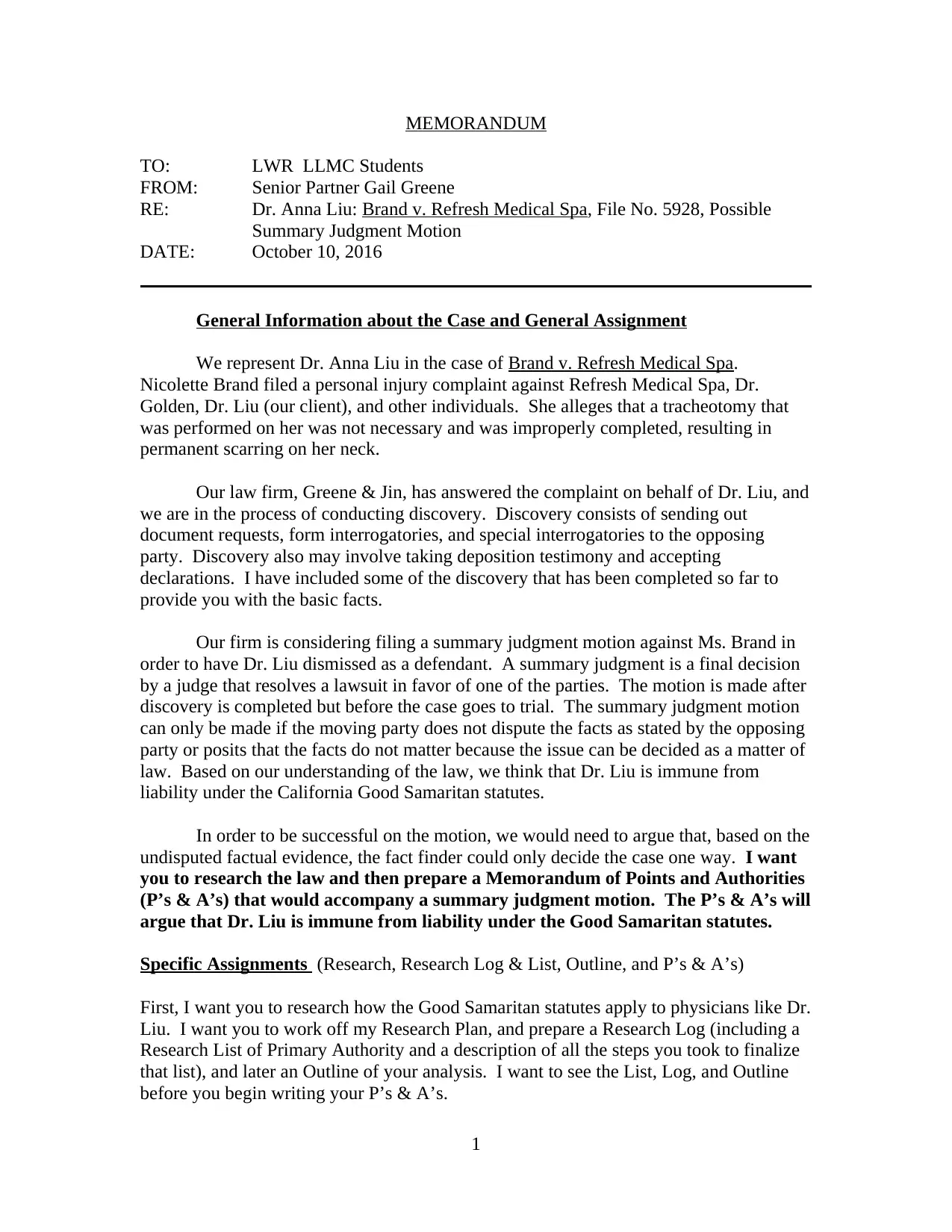
MEMORANDUM
TO: LWR LLMC Students
FROM: Senior Partner Gail Greene
RE: Dr. Anna Liu: Brand v. Refresh Medical Spa, File No. 5928, Possible
Summary Judgment Motion
DATE: October 10, 2016
General Information about the Case and General Assignment
We represent Dr. Anna Liu in the case of Brand v. Refresh Medical Spa.
Nicolette Brand filed a personal injury complaint against Refresh Medical Spa, Dr.
Golden, Dr. Liu (our client), and other individuals. She alleges that a tracheotomy that
was performed on her was not necessary and was improperly completed, resulting in
permanent scarring on her neck.
Our law firm, Greene & Jin, has answered the complaint on behalf of Dr. Liu, and
we are in the process of conducting discovery. Discovery consists of sending out
document requests, form interrogatories, and special interrogatories to the opposing
party. Discovery also may involve taking deposition testimony and accepting
declarations. I have included some of the discovery that has been completed so far to
provide you with the basic facts.
Our firm is considering filing a summary judgment motion against Ms. Brand in
order to have Dr. Liu dismissed as a defendant. A summary judgment is a final decision
by a judge that resolves a lawsuit in favor of one of the parties. The motion is made after
discovery is completed but before the case goes to trial. The summary judgment motion
can only be made if the moving party does not dispute the facts as stated by the opposing
party or posits that the facts do not matter because the issue can be decided as a matter of
law. Based on our understanding of the law, we think that Dr. Liu is immune from
liability under the California Good Samaritan statutes.
In order to be successful on the motion, we would need to argue that, based on the
undisputed factual evidence, the fact finder could only decide the case one way. I want
you to research the law and then prepare a Memorandum of Points and Authorities
(P’s & A’s) that would accompany a summary judgment motion. The P’s & A’s will
argue that Dr. Liu is immune from liability under the Good Samaritan statutes.
Specific Assignments (Research, Research Log & List, Outline, and P’s & A’s)
First, I want you to research how the Good Samaritan statutes apply to physicians like Dr.
Liu. I want you to work off my Research Plan, and prepare a Research Log (including a
Research List of Primary Authority and a description of all the steps you took to finalize
that list), and later an Outline of your analysis. I want to see the List, Log, and Outline
before you begin writing your P’s & A’s.
1
TO: LWR LLMC Students
FROM: Senior Partner Gail Greene
RE: Dr. Anna Liu: Brand v. Refresh Medical Spa, File No. 5928, Possible
Summary Judgment Motion
DATE: October 10, 2016
General Information about the Case and General Assignment
We represent Dr. Anna Liu in the case of Brand v. Refresh Medical Spa.
Nicolette Brand filed a personal injury complaint against Refresh Medical Spa, Dr.
Golden, Dr. Liu (our client), and other individuals. She alleges that a tracheotomy that
was performed on her was not necessary and was improperly completed, resulting in
permanent scarring on her neck.
Our law firm, Greene & Jin, has answered the complaint on behalf of Dr. Liu, and
we are in the process of conducting discovery. Discovery consists of sending out
document requests, form interrogatories, and special interrogatories to the opposing
party. Discovery also may involve taking deposition testimony and accepting
declarations. I have included some of the discovery that has been completed so far to
provide you with the basic facts.
Our firm is considering filing a summary judgment motion against Ms. Brand in
order to have Dr. Liu dismissed as a defendant. A summary judgment is a final decision
by a judge that resolves a lawsuit in favor of one of the parties. The motion is made after
discovery is completed but before the case goes to trial. The summary judgment motion
can only be made if the moving party does not dispute the facts as stated by the opposing
party or posits that the facts do not matter because the issue can be decided as a matter of
law. Based on our understanding of the law, we think that Dr. Liu is immune from
liability under the California Good Samaritan statutes.
In order to be successful on the motion, we would need to argue that, based on the
undisputed factual evidence, the fact finder could only decide the case one way. I want
you to research the law and then prepare a Memorandum of Points and Authorities
(P’s & A’s) that would accompany a summary judgment motion. The P’s & A’s will
argue that Dr. Liu is immune from liability under the Good Samaritan statutes.
Specific Assignments (Research, Research Log & List, Outline, and P’s & A’s)
First, I want you to research how the Good Samaritan statutes apply to physicians like Dr.
Liu. I want you to work off my Research Plan, and prepare a Research Log (including a
Research List of Primary Authority and a description of all the steps you took to finalize
that list), and later an Outline of your analysis. I want to see the List, Log, and Outline
before you begin writing your P’s & A’s.
1
Secure Best Marks with AI Grader
Need help grading? Try our AI Grader for instant feedback on your assignments.
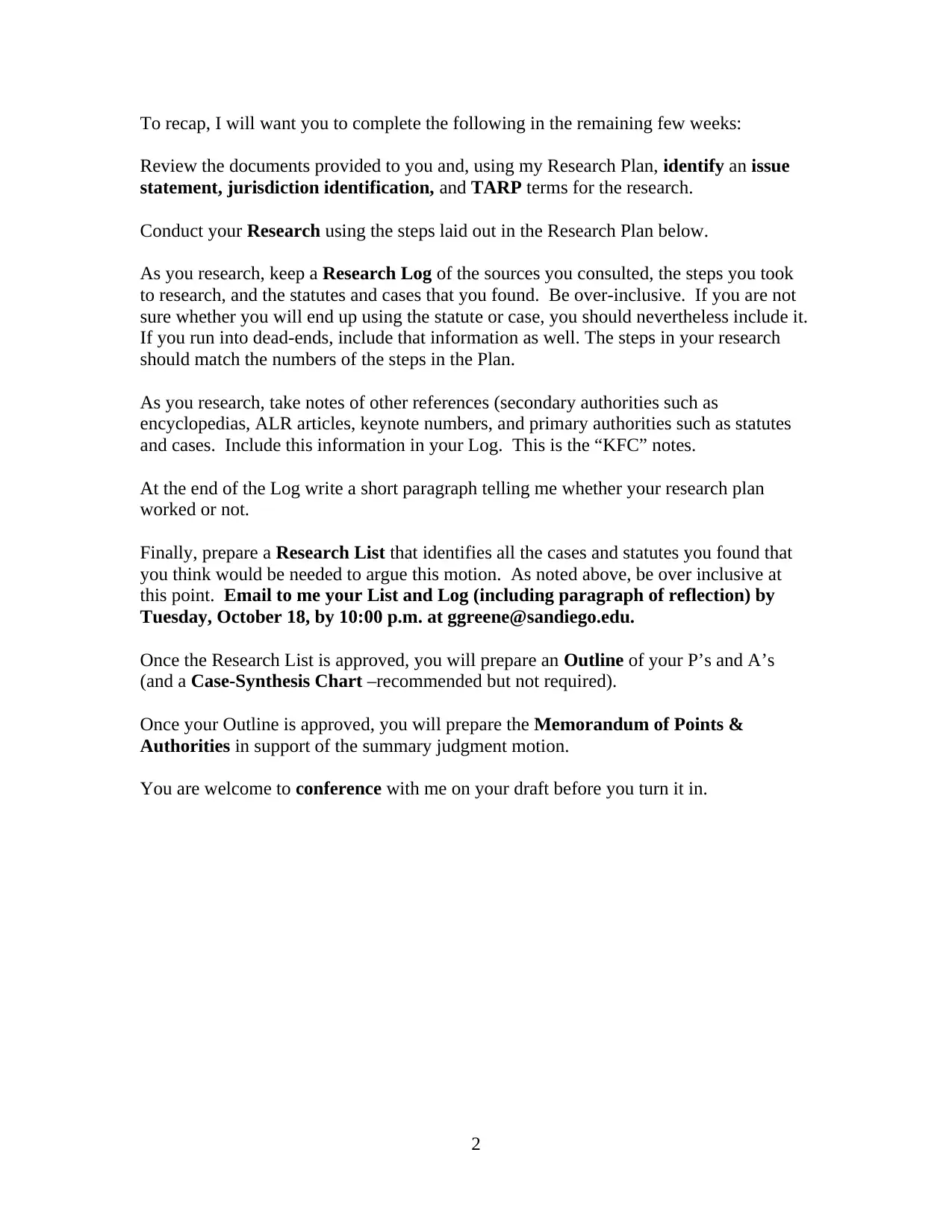
To recap, I will want you to complete the following in the remaining few weeks:
Review the documents provided to you and, using my Research Plan, identify an issue
statement, jurisdiction identification, and TARP terms for the research.
Conduct your Research using the steps laid out in the Research Plan below.
As you research, keep a Research Log of the sources you consulted, the steps you took
to research, and the statutes and cases that you found. Be over-inclusive. If you are not
sure whether you will end up using the statute or case, you should nevertheless include it.
If you run into dead-ends, include that information as well. The steps in your research
should match the numbers of the steps in the Plan.
As you research, take notes of other references (secondary authorities such as
encyclopedias, ALR articles, keynote numbers, and primary authorities such as statutes
and cases. Include this information in your Log. This is the “KFC” notes.
At the end of the Log write a short paragraph telling me whether your research plan
worked or not.
Finally, prepare a Research List that identifies all the cases and statutes you found that
you think would be needed to argue this motion. As noted above, be over inclusive at
this point. Email to me your List and Log (including paragraph of reflection) by
Tuesday, October 18, by 10:00 p.m. at ggreene@sandiego.edu.
Once the Research List is approved, you will prepare an Outline of your P’s and A’s
(and a Case-Synthesis Chart –recommended but not required).
Once your Outline is approved, you will prepare the Memorandum of Points &
Authorities in support of the summary judgment motion.
You are welcome to conference with me on your draft before you turn it in.
2
Review the documents provided to you and, using my Research Plan, identify an issue
statement, jurisdiction identification, and TARP terms for the research.
Conduct your Research using the steps laid out in the Research Plan below.
As you research, keep a Research Log of the sources you consulted, the steps you took
to research, and the statutes and cases that you found. Be over-inclusive. If you are not
sure whether you will end up using the statute or case, you should nevertheless include it.
If you run into dead-ends, include that information as well. The steps in your research
should match the numbers of the steps in the Plan.
As you research, take notes of other references (secondary authorities such as
encyclopedias, ALR articles, keynote numbers, and primary authorities such as statutes
and cases. Include this information in your Log. This is the “KFC” notes.
At the end of the Log write a short paragraph telling me whether your research plan
worked or not.
Finally, prepare a Research List that identifies all the cases and statutes you found that
you think would be needed to argue this motion. As noted above, be over inclusive at
this point. Email to me your List and Log (including paragraph of reflection) by
Tuesday, October 18, by 10:00 p.m. at ggreene@sandiego.edu.
Once the Research List is approved, you will prepare an Outline of your P’s and A’s
(and a Case-Synthesis Chart –recommended but not required).
Once your Outline is approved, you will prepare the Memorandum of Points &
Authorities in support of the summary judgment motion.
You are welcome to conference with me on your draft before you turn it in.
2
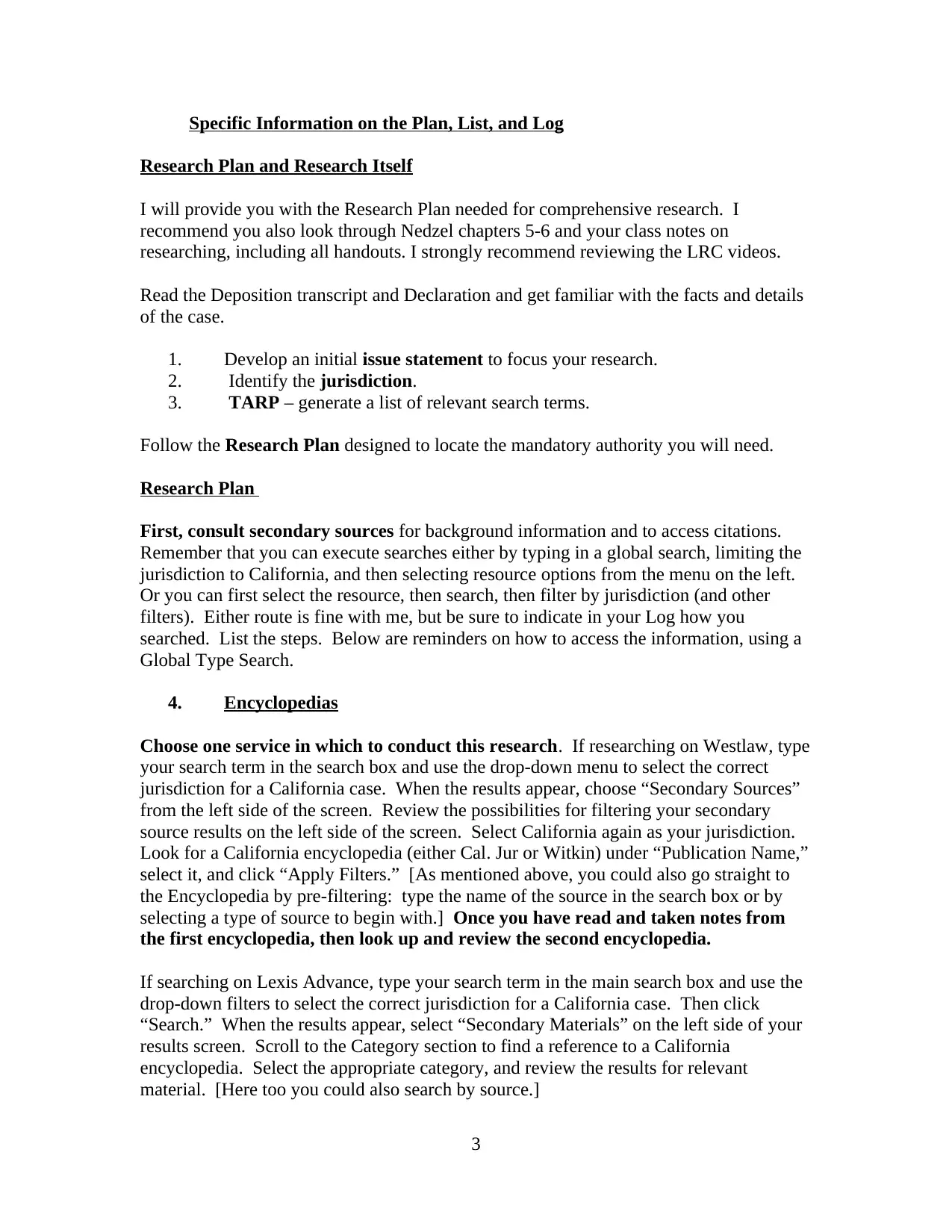
Specific Information on the Plan, List, and Log
Research Plan and Research Itself
I will provide you with the Research Plan needed for comprehensive research. I
recommend you also look through Nedzel chapters 5-6 and your class notes on
researching, including all handouts. I strongly recommend reviewing the LRC videos.
Read the Deposition transcript and Declaration and get familiar with the facts and details
of the case.
1. Develop an initial issue statement to focus your research.
2. Identify the jurisdiction.
3. TARP – generate a list of relevant search terms.
Follow the Research Plan designed to locate the mandatory authority you will need.
Research Plan
First, consult secondary sources for background information and to access citations.
Remember that you can execute searches either by typing in a global search, limiting the
jurisdiction to California, and then selecting resource options from the menu on the left.
Or you can first select the resource, then search, then filter by jurisdiction (and other
filters). Either route is fine with me, but be sure to indicate in your Log how you
searched. List the steps. Below are reminders on how to access the information, using a
Global Type Search.
4. Encyclopedias
Choose one service in which to conduct this research. If researching on Westlaw, type
your search term in the search box and use the drop-down menu to select the correct
jurisdiction for a California case. When the results appear, choose “Secondary Sources”
from the left side of the screen. Review the possibilities for filtering your secondary
source results on the left side of the screen. Select California again as your jurisdiction.
Look for a California encyclopedia (either Cal. Jur or Witkin) under “Publication Name,”
select it, and click “Apply Filters.” [As mentioned above, you could also go straight to
the Encyclopedia by pre-filtering: type the name of the source in the search box or by
selecting a type of source to begin with.] Once you have read and taken notes from
the first encyclopedia, then look up and review the second encyclopedia.
If searching on Lexis Advance, type your search term in the main search box and use the
drop-down filters to select the correct jurisdiction for a California case. Then click
“Search.” When the results appear, select “Secondary Materials” on the left side of your
results screen. Scroll to the Category section to find a reference to a California
encyclopedia. Select the appropriate category, and review the results for relevant
material. [Here too you could also search by source.]
3
Research Plan and Research Itself
I will provide you with the Research Plan needed for comprehensive research. I
recommend you also look through Nedzel chapters 5-6 and your class notes on
researching, including all handouts. I strongly recommend reviewing the LRC videos.
Read the Deposition transcript and Declaration and get familiar with the facts and details
of the case.
1. Develop an initial issue statement to focus your research.
2. Identify the jurisdiction.
3. TARP – generate a list of relevant search terms.
Follow the Research Plan designed to locate the mandatory authority you will need.
Research Plan
First, consult secondary sources for background information and to access citations.
Remember that you can execute searches either by typing in a global search, limiting the
jurisdiction to California, and then selecting resource options from the menu on the left.
Or you can first select the resource, then search, then filter by jurisdiction (and other
filters). Either route is fine with me, but be sure to indicate in your Log how you
searched. List the steps. Below are reminders on how to access the information, using a
Global Type Search.
4. Encyclopedias
Choose one service in which to conduct this research. If researching on Westlaw, type
your search term in the search box and use the drop-down menu to select the correct
jurisdiction for a California case. When the results appear, choose “Secondary Sources”
from the left side of the screen. Review the possibilities for filtering your secondary
source results on the left side of the screen. Select California again as your jurisdiction.
Look for a California encyclopedia (either Cal. Jur or Witkin) under “Publication Name,”
select it, and click “Apply Filters.” [As mentioned above, you could also go straight to
the Encyclopedia by pre-filtering: type the name of the source in the search box or by
selecting a type of source to begin with.] Once you have read and taken notes from
the first encyclopedia, then look up and review the second encyclopedia.
If searching on Lexis Advance, type your search term in the main search box and use the
drop-down filters to select the correct jurisdiction for a California case. Then click
“Search.” When the results appear, select “Secondary Materials” on the left side of your
results screen. Scroll to the Category section to find a reference to a California
encyclopedia. Select the appropriate category, and review the results for relevant
material. [Here too you could also search by source.]
3
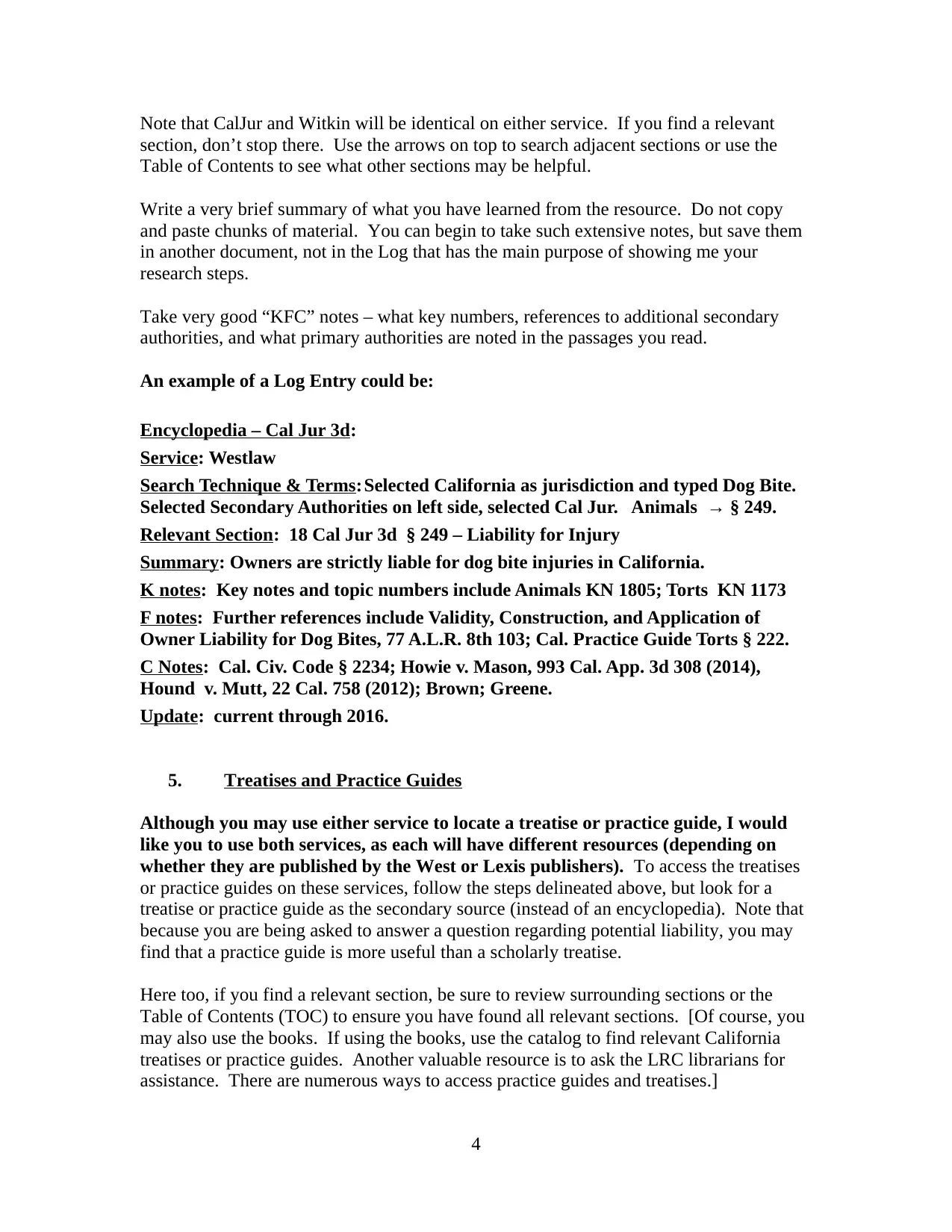
Note that CalJur and Witkin will be identical on either service. If you find a relevant
section, don’t stop there. Use the arrows on top to search adjacent sections or use the
Table of Contents to see what other sections may be helpful.
Write a very brief summary of what you have learned from the resource. Do not copy
and paste chunks of material. You can begin to take such extensive notes, but save them
in another document, not in the Log that has the main purpose of showing me your
research steps.
Take very good “KFC” notes – what key numbers, references to additional secondary
authorities, and what primary authorities are noted in the passages you read.
An example of a Log Entry could be:
Encyclopedia – Cal Jur 3d:
Service: Westlaw
Search Technique & Terms:Selected California as jurisdiction and typed Dog Bite.
Selected Secondary Authorities on left side, selected Cal Jur. Animals → § 249.
Relevant Section: 18 Cal Jur 3d § 249 – Liability for Injury
Summary: Owners are strictly liable for dog bite injuries in California.
K notes: Key notes and topic numbers include Animals KN 1805; Torts KN 1173
F notes: Further references include Validity, Construction, and Application of
Owner Liability for Dog Bites, 77 A.L.R. 8th 103; Cal. Practice Guide Torts § 222.
C Notes: Cal. Civ. Code § 2234; Howie v. Mason, 993 Cal. App. 3d 308 (2014),
Hound v. Mutt, 22 Cal. 758 (2012); Brown; Greene.
Update: current through 2016.
5. Treatises and Practice Guides
Although you may use either service to locate a treatise or practice guide, I would
like you to use both services, as each will have different resources (depending on
whether they are published by the West or Lexis publishers). To access the treatises
or practice guides on these services, follow the steps delineated above, but look for a
treatise or practice guide as the secondary source (instead of an encyclopedia). Note that
because you are being asked to answer a question regarding potential liability, you may
find that a practice guide is more useful than a scholarly treatise.
Here too, if you find a relevant section, be sure to review surrounding sections or the
Table of Contents (TOC) to ensure you have found all relevant sections. [Of course, you
may also use the books. If using the books, use the catalog to find relevant California
treatises or practice guides. Another valuable resource is to ask the LRC librarians for
assistance. There are numerous ways to access practice guides and treatises.]
4
section, don’t stop there. Use the arrows on top to search adjacent sections or use the
Table of Contents to see what other sections may be helpful.
Write a very brief summary of what you have learned from the resource. Do not copy
and paste chunks of material. You can begin to take such extensive notes, but save them
in another document, not in the Log that has the main purpose of showing me your
research steps.
Take very good “KFC” notes – what key numbers, references to additional secondary
authorities, and what primary authorities are noted in the passages you read.
An example of a Log Entry could be:
Encyclopedia – Cal Jur 3d:
Service: Westlaw
Search Technique & Terms:Selected California as jurisdiction and typed Dog Bite.
Selected Secondary Authorities on left side, selected Cal Jur. Animals → § 249.
Relevant Section: 18 Cal Jur 3d § 249 – Liability for Injury
Summary: Owners are strictly liable for dog bite injuries in California.
K notes: Key notes and topic numbers include Animals KN 1805; Torts KN 1173
F notes: Further references include Validity, Construction, and Application of
Owner Liability for Dog Bites, 77 A.L.R. 8th 103; Cal. Practice Guide Torts § 222.
C Notes: Cal. Civ. Code § 2234; Howie v. Mason, 993 Cal. App. 3d 308 (2014),
Hound v. Mutt, 22 Cal. 758 (2012); Brown; Greene.
Update: current through 2016.
5. Treatises and Practice Guides
Although you may use either service to locate a treatise or practice guide, I would
like you to use both services, as each will have different resources (depending on
whether they are published by the West or Lexis publishers). To access the treatises
or practice guides on these services, follow the steps delineated above, but look for a
treatise or practice guide as the secondary source (instead of an encyclopedia). Note that
because you are being asked to answer a question regarding potential liability, you may
find that a practice guide is more useful than a scholarly treatise.
Here too, if you find a relevant section, be sure to review surrounding sections or the
Table of Contents (TOC) to ensure you have found all relevant sections. [Of course, you
may also use the books. If using the books, use the catalog to find relevant California
treatises or practice guides. Another valuable resource is to ask the LRC librarians for
assistance. There are numerous ways to access practice guides and treatises.]
4
Secure Best Marks with AI Grader
Need help grading? Try our AI Grader for instant feedback on your assignments.
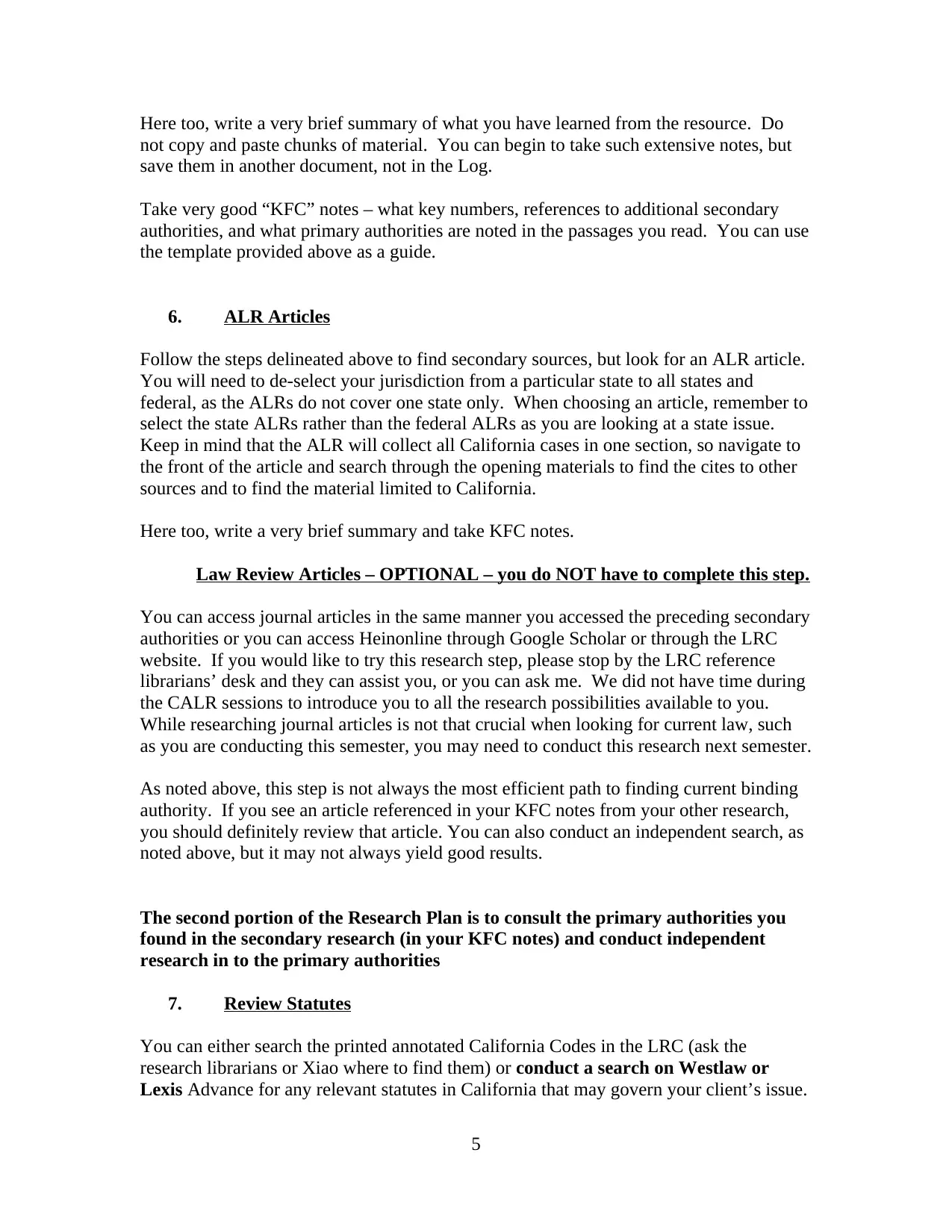
Here too, write a very brief summary of what you have learned from the resource. Do
not copy and paste chunks of material. You can begin to take such extensive notes, but
save them in another document, not in the Log.
Take very good “KFC” notes – what key numbers, references to additional secondary
authorities, and what primary authorities are noted in the passages you read. You can use
the template provided above as a guide.
6. ALR Articles
Follow the steps delineated above to find secondary sources, but look for an ALR article.
You will need to de-select your jurisdiction from a particular state to all states and
federal, as the ALRs do not cover one state only. When choosing an article, remember to
select the state ALRs rather than the federal ALRs as you are looking at a state issue.
Keep in mind that the ALR will collect all California cases in one section, so navigate to
the front of the article and search through the opening materials to find the cites to other
sources and to find the material limited to California.
Here too, write a very brief summary and take KFC notes.
Law Review Articles – OPTIONAL – you do NOT have to complete this step.
You can access journal articles in the same manner you accessed the preceding secondary
authorities or you can access Heinonline through Google Scholar or through the LRC
website. If you would like to try this research step, please stop by the LRC reference
librarians’ desk and they can assist you, or you can ask me. We did not have time during
the CALR sessions to introduce you to all the research possibilities available to you.
While researching journal articles is not that crucial when looking for current law, such
as you are conducting this semester, you may need to conduct this research next semester.
As noted above, this step is not always the most efficient path to finding current binding
authority. If you see an article referenced in your KFC notes from your other research,
you should definitely review that article. You can also conduct an independent search, as
noted above, but it may not always yield good results.
The second portion of the Research Plan is to consult the primary authorities you
found in the secondary research (in your KFC notes) and conduct independent
research in to the primary authorities
7. Review Statutes
You can either search the printed annotated California Codes in the LRC (ask the
research librarians or Xiao where to find them) or conduct a search on Westlaw or
Lexis Advance for any relevant statutes in California that may govern your client’s issue.
5
not copy and paste chunks of material. You can begin to take such extensive notes, but
save them in another document, not in the Log.
Take very good “KFC” notes – what key numbers, references to additional secondary
authorities, and what primary authorities are noted in the passages you read. You can use
the template provided above as a guide.
6. ALR Articles
Follow the steps delineated above to find secondary sources, but look for an ALR article.
You will need to de-select your jurisdiction from a particular state to all states and
federal, as the ALRs do not cover one state only. When choosing an article, remember to
select the state ALRs rather than the federal ALRs as you are looking at a state issue.
Keep in mind that the ALR will collect all California cases in one section, so navigate to
the front of the article and search through the opening materials to find the cites to other
sources and to find the material limited to California.
Here too, write a very brief summary and take KFC notes.
Law Review Articles – OPTIONAL – you do NOT have to complete this step.
You can access journal articles in the same manner you accessed the preceding secondary
authorities or you can access Heinonline through Google Scholar or through the LRC
website. If you would like to try this research step, please stop by the LRC reference
librarians’ desk and they can assist you, or you can ask me. We did not have time during
the CALR sessions to introduce you to all the research possibilities available to you.
While researching journal articles is not that crucial when looking for current law, such
as you are conducting this semester, you may need to conduct this research next semester.
As noted above, this step is not always the most efficient path to finding current binding
authority. If you see an article referenced in your KFC notes from your other research,
you should definitely review that article. You can also conduct an independent search, as
noted above, but it may not always yield good results.
The second portion of the Research Plan is to consult the primary authorities you
found in the secondary research (in your KFC notes) and conduct independent
research in to the primary authorities
7. Review Statutes
You can either search the printed annotated California Codes in the LRC (ask the
research librarians or Xiao where to find them) or conduct a search on Westlaw or
Lexis Advance for any relevant statutes in California that may govern your client’s issue.
5
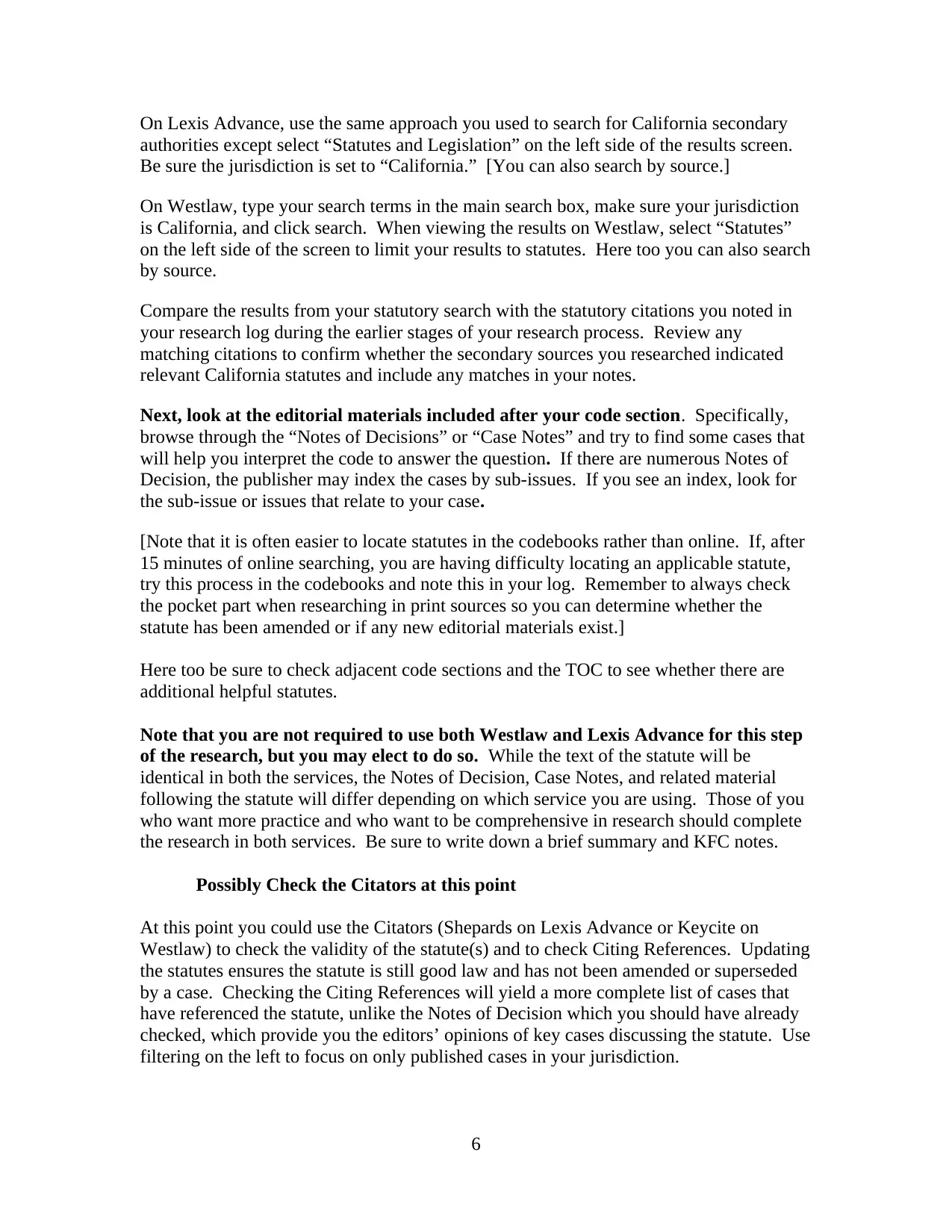
On Lexis Advance, use the same approach you used to search for California secondary
authorities except select “Statutes and Legislation” on the left side of the results screen.
Be sure the jurisdiction is set to “California.” [You can also search by source.]
On Westlaw, type your search terms in the main search box, make sure your jurisdiction
is California, and click search. When viewing the results on Westlaw, select “Statutes”
on the left side of the screen to limit your results to statutes. Here too you can also search
by source.
Compare the results from your statutory search with the statutory citations you noted in
your research log during the earlier stages of your research process. Review any
matching citations to confirm whether the secondary sources you researched indicated
relevant California statutes and include any matches in your notes.
Next, look at the editorial materials included after your code section. Specifically,
browse through the “Notes of Decisions” or “Case Notes” and try to find some cases that
will help you interpret the code to answer the question. If there are numerous Notes of
Decision, the publisher may index the cases by sub-issues. If you see an index, look for
the sub-issue or issues that relate to your case.
[Note that it is often easier to locate statutes in the codebooks rather than online. If, after
15 minutes of online searching, you are having difficulty locating an applicable statute,
try this process in the codebooks and note this in your log. Remember to always check
the pocket part when researching in print sources so you can determine whether the
statute has been amended or if any new editorial materials exist.]
Here too be sure to check adjacent code sections and the TOC to see whether there are
additional helpful statutes.
Note that you are not required to use both Westlaw and Lexis Advance for this step
of the research, but you may elect to do so. While the text of the statute will be
identical in both the services, the Notes of Decision, Case Notes, and related material
following the statute will differ depending on which service you are using. Those of you
who want more practice and who want to be comprehensive in research should complete
the research in both services. Be sure to write down a brief summary and KFC notes.
Possibly Check the Citators at this point
At this point you could use the Citators (Shepards on Lexis Advance or Keycite on
Westlaw) to check the validity of the statute(s) and to check Citing References. Updating
the statutes ensures the statute is still good law and has not been amended or superseded
by a case. Checking the Citing References will yield a more complete list of cases that
have referenced the statute, unlike the Notes of Decision which you should have already
checked, which provide you the editors’ opinions of key cases discussing the statute. Use
filtering on the left to focus on only published cases in your jurisdiction.
6
authorities except select “Statutes and Legislation” on the left side of the results screen.
Be sure the jurisdiction is set to “California.” [You can also search by source.]
On Westlaw, type your search terms in the main search box, make sure your jurisdiction
is California, and click search. When viewing the results on Westlaw, select “Statutes”
on the left side of the screen to limit your results to statutes. Here too you can also search
by source.
Compare the results from your statutory search with the statutory citations you noted in
your research log during the earlier stages of your research process. Review any
matching citations to confirm whether the secondary sources you researched indicated
relevant California statutes and include any matches in your notes.
Next, look at the editorial materials included after your code section. Specifically,
browse through the “Notes of Decisions” or “Case Notes” and try to find some cases that
will help you interpret the code to answer the question. If there are numerous Notes of
Decision, the publisher may index the cases by sub-issues. If you see an index, look for
the sub-issue or issues that relate to your case.
[Note that it is often easier to locate statutes in the codebooks rather than online. If, after
15 minutes of online searching, you are having difficulty locating an applicable statute,
try this process in the codebooks and note this in your log. Remember to always check
the pocket part when researching in print sources so you can determine whether the
statute has been amended or if any new editorial materials exist.]
Here too be sure to check adjacent code sections and the TOC to see whether there are
additional helpful statutes.
Note that you are not required to use both Westlaw and Lexis Advance for this step
of the research, but you may elect to do so. While the text of the statute will be
identical in both the services, the Notes of Decision, Case Notes, and related material
following the statute will differ depending on which service you are using. Those of you
who want more practice and who want to be comprehensive in research should complete
the research in both services. Be sure to write down a brief summary and KFC notes.
Possibly Check the Citators at this point
At this point you could use the Citators (Shepards on Lexis Advance or Keycite on
Westlaw) to check the validity of the statute(s) and to check Citing References. Updating
the statutes ensures the statute is still good law and has not been amended or superseded
by a case. Checking the Citing References will yield a more complete list of cases that
have referenced the statute, unlike the Notes of Decision which you should have already
checked, which provide you the editors’ opinions of key cases discussing the statute. Use
filtering on the left to focus on only published cases in your jurisdiction.
6
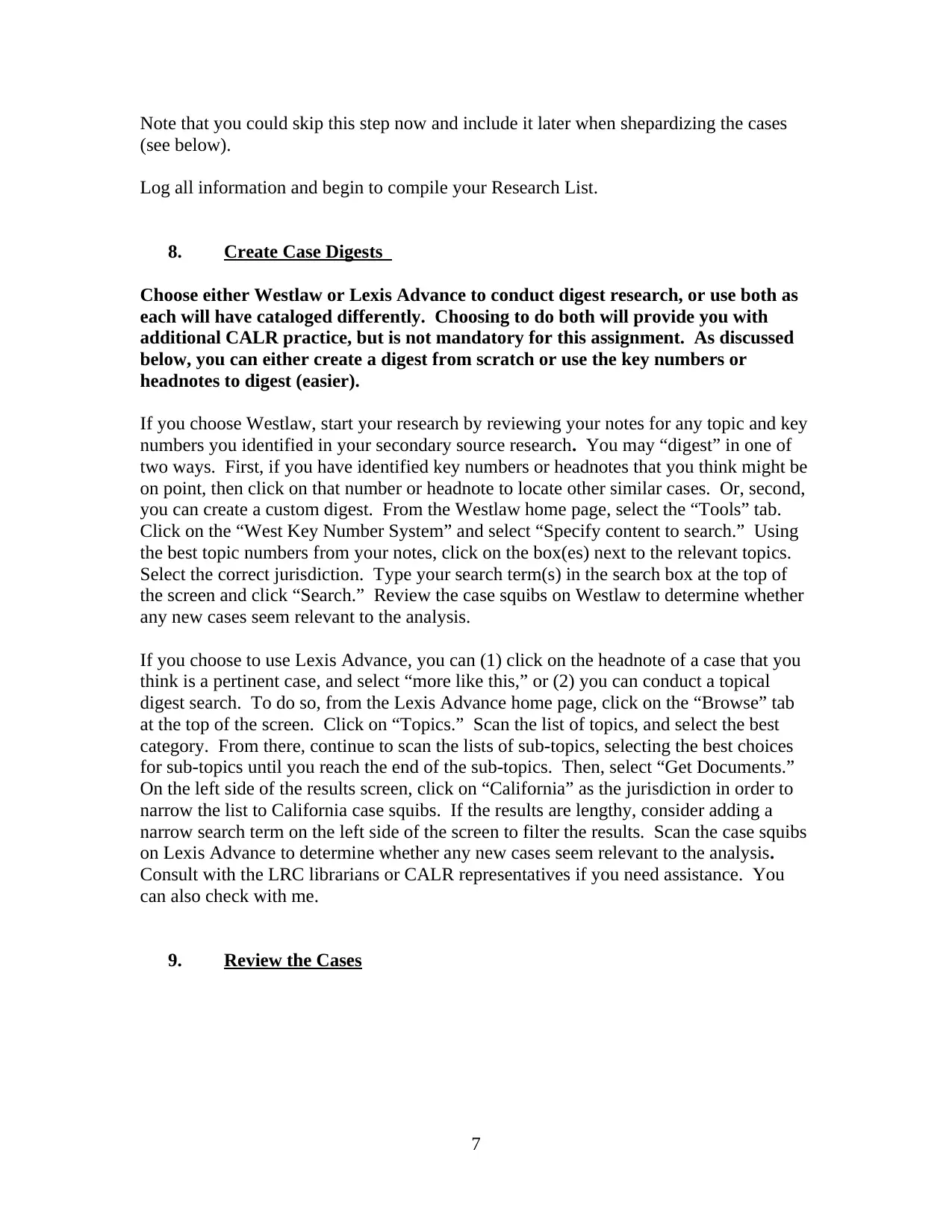
Note that you could skip this step now and include it later when shepardizing the cases
(see below).
Log all information and begin to compile your Research List.
8. Create Case Digests
Choose either Westlaw or Lexis Advance to conduct digest research, or use both as
each will have cataloged differently. Choosing to do both will provide you with
additional CALR practice, but is not mandatory for this assignment. As discussed
below, you can either create a digest from scratch or use the key numbers or
headnotes to digest (easier).
If you choose Westlaw, start your research by reviewing your notes for any topic and key
numbers you identified in your secondary source research. You may “digest” in one of
two ways. First, if you have identified key numbers or headnotes that you think might be
on point, then click on that number or headnote to locate other similar cases. Or, second,
you can create a custom digest. From the Westlaw home page, select the “Tools” tab.
Click on the “West Key Number System” and select “Specify content to search.” Using
the best topic numbers from your notes, click on the box(es) next to the relevant topics.
Select the correct jurisdiction. Type your search term(s) in the search box at the top of
the screen and click “Search.” Review the case squibs on Westlaw to determine whether
any new cases seem relevant to the analysis.
If you choose to use Lexis Advance, you can (1) click on the headnote of a case that you
think is a pertinent case, and select “more like this,” or (2) you can conduct a topical
digest search. To do so, from the Lexis Advance home page, click on the “Browse” tab
at the top of the screen. Click on “Topics.” Scan the list of topics, and select the best
category. From there, continue to scan the lists of sub-topics, selecting the best choices
for sub-topics until you reach the end of the sub-topics. Then, select “Get Documents.”
On the left side of the results screen, click on “California” as the jurisdiction in order to
narrow the list to California case squibs. If the results are lengthy, consider adding a
narrow search term on the left side of the screen to filter the results. Scan the case squibs
on Lexis Advance to determine whether any new cases seem relevant to the analysis.
Consult with the LRC librarians or CALR representatives if you need assistance. You
can also check with me.
9. Review the Cases
7
(see below).
Log all information and begin to compile your Research List.
8. Create Case Digests
Choose either Westlaw or Lexis Advance to conduct digest research, or use both as
each will have cataloged differently. Choosing to do both will provide you with
additional CALR practice, but is not mandatory for this assignment. As discussed
below, you can either create a digest from scratch or use the key numbers or
headnotes to digest (easier).
If you choose Westlaw, start your research by reviewing your notes for any topic and key
numbers you identified in your secondary source research. You may “digest” in one of
two ways. First, if you have identified key numbers or headnotes that you think might be
on point, then click on that number or headnote to locate other similar cases. Or, second,
you can create a custom digest. From the Westlaw home page, select the “Tools” tab.
Click on the “West Key Number System” and select “Specify content to search.” Using
the best topic numbers from your notes, click on the box(es) next to the relevant topics.
Select the correct jurisdiction. Type your search term(s) in the search box at the top of
the screen and click “Search.” Review the case squibs on Westlaw to determine whether
any new cases seem relevant to the analysis.
If you choose to use Lexis Advance, you can (1) click on the headnote of a case that you
think is a pertinent case, and select “more like this,” or (2) you can conduct a topical
digest search. To do so, from the Lexis Advance home page, click on the “Browse” tab
at the top of the screen. Click on “Topics.” Scan the list of topics, and select the best
category. From there, continue to scan the lists of sub-topics, selecting the best choices
for sub-topics until you reach the end of the sub-topics. Then, select “Get Documents.”
On the left side of the results screen, click on “California” as the jurisdiction in order to
narrow the list to California case squibs. If the results are lengthy, consider adding a
narrow search term on the left side of the screen to filter the results. Scan the case squibs
on Lexis Advance to determine whether any new cases seem relevant to the analysis.
Consult with the LRC librarians or CALR representatives if you need assistance. You
can also check with me.
9. Review the Cases
7
Paraphrase This Document
Need a fresh take? Get an instant paraphrase of this document with our AI Paraphraser
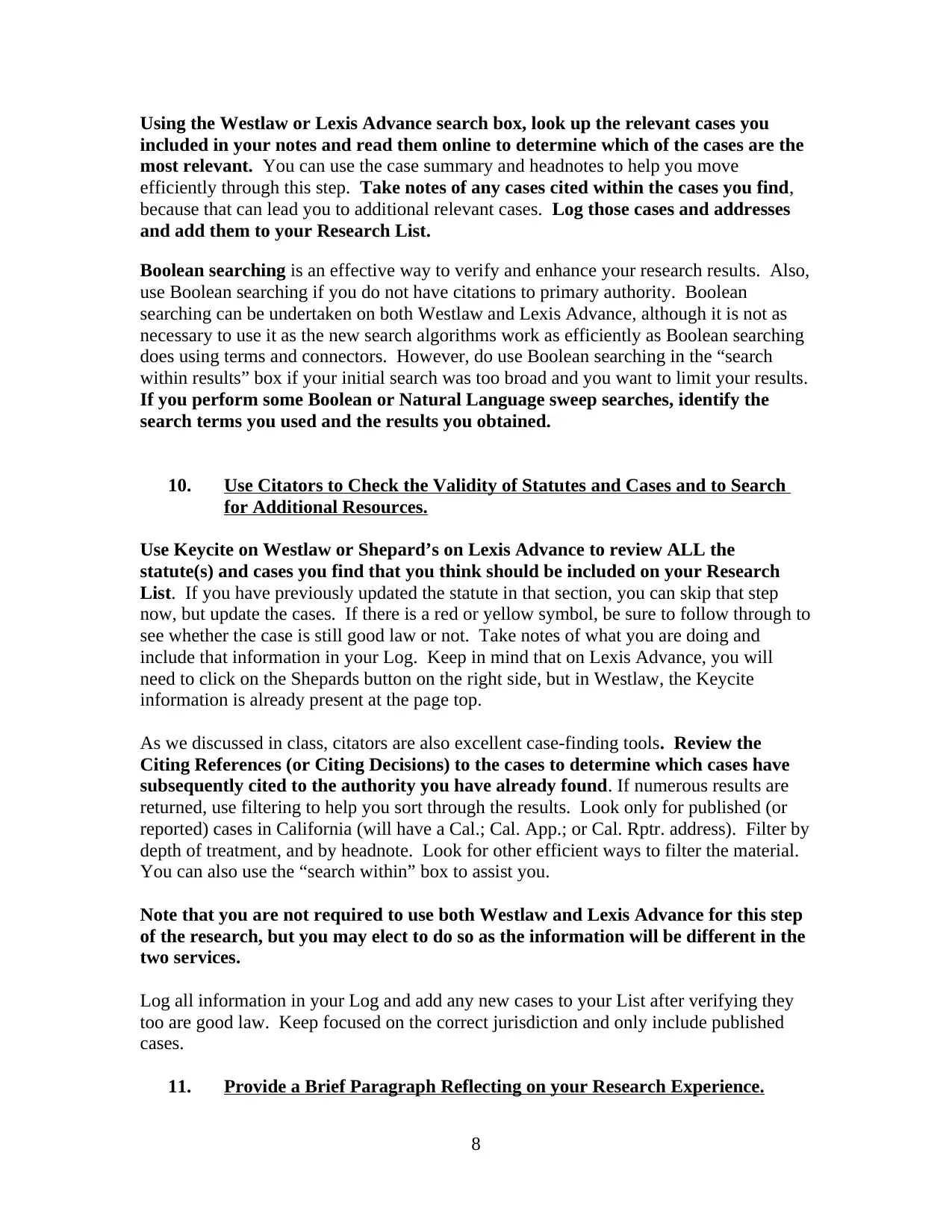
Using the Westlaw or Lexis Advance search box, look up the relevant cases you
included in your notes and read them online to determine which of the cases are the
most relevant. You can use the case summary and headnotes to help you move
efficiently through this step. Take notes of any cases cited within the cases you find,
because that can lead you to additional relevant cases. Log those cases and addresses
and add them to your Research List.
Boolean searching is an effective way to verify and enhance your research results. Also,
use Boolean searching if you do not have citations to primary authority. Boolean
searching can be undertaken on both Westlaw and Lexis Advance, although it is not as
necessary to use it as the new search algorithms work as efficiently as Boolean searching
does using terms and connectors. However, do use Boolean searching in the “search
within results” box if your initial search was too broad and you want to limit your results.
If you perform some Boolean or Natural Language sweep searches, identify the
search terms you used and the results you obtained.
10. Use Citators to Check the Validity of Statutes and Cases and to Search
for Additional Resources.
Use Keycite on Westlaw or Shepard’s on Lexis Advance to review ALL the
statute(s) and cases you find that you think should be included on your Research
List. If you have previously updated the statute in that section, you can skip that step
now, but update the cases. If there is a red or yellow symbol, be sure to follow through to
see whether the case is still good law or not. Take notes of what you are doing and
include that information in your Log. Keep in mind that on Lexis Advance, you will
need to click on the Shepards button on the right side, but in Westlaw, the Keycite
information is already present at the page top.
As we discussed in class, citators are also excellent case-finding tools. Review the
Citing References (or Citing Decisions) to the cases to determine which cases have
subsequently cited to the authority you have already found. If numerous results are
returned, use filtering to help you sort through the results. Look only for published (or
reported) cases in California (will have a Cal.; Cal. App.; or Cal. Rptr. address). Filter by
depth of treatment, and by headnote. Look for other efficient ways to filter the material.
You can also use the “search within” box to assist you.
Note that you are not required to use both Westlaw and Lexis Advance for this step
of the research, but you may elect to do so as the information will be different in the
two services.
Log all information in your Log and add any new cases to your List after verifying they
too are good law. Keep focused on the correct jurisdiction and only include published
cases.
11. Provide a Brief Paragraph Reflecting on your Research Experience.
8
included in your notes and read them online to determine which of the cases are the
most relevant. You can use the case summary and headnotes to help you move
efficiently through this step. Take notes of any cases cited within the cases you find,
because that can lead you to additional relevant cases. Log those cases and addresses
and add them to your Research List.
Boolean searching is an effective way to verify and enhance your research results. Also,
use Boolean searching if you do not have citations to primary authority. Boolean
searching can be undertaken on both Westlaw and Lexis Advance, although it is not as
necessary to use it as the new search algorithms work as efficiently as Boolean searching
does using terms and connectors. However, do use Boolean searching in the “search
within results” box if your initial search was too broad and you want to limit your results.
If you perform some Boolean or Natural Language sweep searches, identify the
search terms you used and the results you obtained.
10. Use Citators to Check the Validity of Statutes and Cases and to Search
for Additional Resources.
Use Keycite on Westlaw or Shepard’s on Lexis Advance to review ALL the
statute(s) and cases you find that you think should be included on your Research
List. If you have previously updated the statute in that section, you can skip that step
now, but update the cases. If there is a red or yellow symbol, be sure to follow through to
see whether the case is still good law or not. Take notes of what you are doing and
include that information in your Log. Keep in mind that on Lexis Advance, you will
need to click on the Shepards button on the right side, but in Westlaw, the Keycite
information is already present at the page top.
As we discussed in class, citators are also excellent case-finding tools. Review the
Citing References (or Citing Decisions) to the cases to determine which cases have
subsequently cited to the authority you have already found. If numerous results are
returned, use filtering to help you sort through the results. Look only for published (or
reported) cases in California (will have a Cal.; Cal. App.; or Cal. Rptr. address). Filter by
depth of treatment, and by headnote. Look for other efficient ways to filter the material.
You can also use the “search within” box to assist you.
Note that you are not required to use both Westlaw and Lexis Advance for this step
of the research, but you may elect to do so as the information will be different in the
two services.
Log all information in your Log and add any new cases to your List after verifying they
too are good law. Keep focused on the correct jurisdiction and only include published
cases.
11. Provide a Brief Paragraph Reflecting on your Research Experience.
8
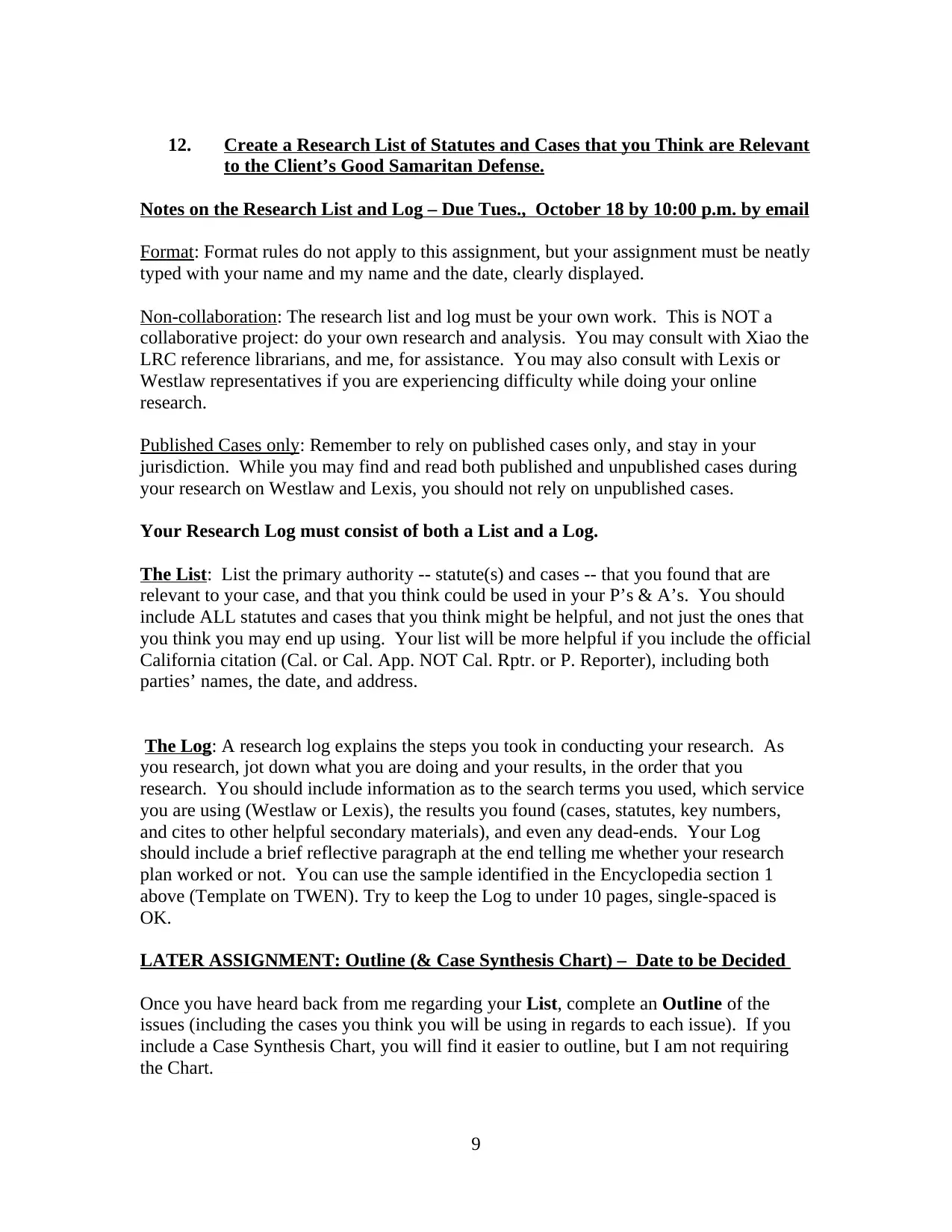
12. Create a Research List of Statutes and Cases that you Think are Relevant
to the Client’s Good Samaritan Defense.
Notes on the Research List and Log – Due Tues., October 18 by 10:00 p.m. by email
Format: Format rules do not apply to this assignment, but your assignment must be neatly
typed with your name and my name and the date, clearly displayed.
Non-collaboration: The research list and log must be your own work. This is NOT a
collaborative project: do your own research and analysis. You may consult with Xiao the
LRC reference librarians, and me, for assistance. You may also consult with Lexis or
Westlaw representatives if you are experiencing difficulty while doing your online
research.
Published Cases only: Remember to rely on published cases only, and stay in your
jurisdiction. While you may find and read both published and unpublished cases during
your research on Westlaw and Lexis, you should not rely on unpublished cases.
Your Research Log must consist of both a List and a Log.
The List: List the primary authority -- statute(s) and cases -- that you found that are
relevant to your case, and that you think could be used in your P’s & A’s. You should
include ALL statutes and cases that you think might be helpful, and not just the ones that
you think you may end up using. Your list will be more helpful if you include the official
California citation (Cal. or Cal. App. NOT Cal. Rptr. or P. Reporter), including both
parties’ names, the date, and address.
The Log: A research log explains the steps you took in conducting your research. As
you research, jot down what you are doing and your results, in the order that you
research. You should include information as to the search terms you used, which service
you are using (Westlaw or Lexis), the results you found (cases, statutes, key numbers,
and cites to other helpful secondary materials), and even any dead-ends. Your Log
should include a brief reflective paragraph at the end telling me whether your research
plan worked or not. You can use the sample identified in the Encyclopedia section 1
above (Template on TWEN). Try to keep the Log to under 10 pages, single-spaced is
OK.
LATER ASSIGNMENT: Outline (& Case Synthesis Chart) – Date to be Decided
Once you have heard back from me regarding your List, complete an Outline of the
issues (including the cases you think you will be using in regards to each issue). If you
include a Case Synthesis Chart, you will find it easier to outline, but I am not requiring
the Chart.
9
to the Client’s Good Samaritan Defense.
Notes on the Research List and Log – Due Tues., October 18 by 10:00 p.m. by email
Format: Format rules do not apply to this assignment, but your assignment must be neatly
typed with your name and my name and the date, clearly displayed.
Non-collaboration: The research list and log must be your own work. This is NOT a
collaborative project: do your own research and analysis. You may consult with Xiao the
LRC reference librarians, and me, for assistance. You may also consult with Lexis or
Westlaw representatives if you are experiencing difficulty while doing your online
research.
Published Cases only: Remember to rely on published cases only, and stay in your
jurisdiction. While you may find and read both published and unpublished cases during
your research on Westlaw and Lexis, you should not rely on unpublished cases.
Your Research Log must consist of both a List and a Log.
The List: List the primary authority -- statute(s) and cases -- that you found that are
relevant to your case, and that you think could be used in your P’s & A’s. You should
include ALL statutes and cases that you think might be helpful, and not just the ones that
you think you may end up using. Your list will be more helpful if you include the official
California citation (Cal. or Cal. App. NOT Cal. Rptr. or P. Reporter), including both
parties’ names, the date, and address.
The Log: A research log explains the steps you took in conducting your research. As
you research, jot down what you are doing and your results, in the order that you
research. You should include information as to the search terms you used, which service
you are using (Westlaw or Lexis), the results you found (cases, statutes, key numbers,
and cites to other helpful secondary materials), and even any dead-ends. Your Log
should include a brief reflective paragraph at the end telling me whether your research
plan worked or not. You can use the sample identified in the Encyclopedia section 1
above (Template on TWEN). Try to keep the Log to under 10 pages, single-spaced is
OK.
LATER ASSIGNMENT: Outline (& Case Synthesis Chart) – Date to be Decided
Once you have heard back from me regarding your List, complete an Outline of the
issues (including the cases you think you will be using in regards to each issue). If you
include a Case Synthesis Chart, you will find it easier to outline, but I am not requiring
the Chart.
9

The assignment must be neatly typed with your name, my name, and the date, clearly
displayed. If you prepare a Chart, that does not need to be typed, but it must be legible.
You should use a version of CREARC to outline your P’s and A’s with a brief
explanation of what you plan to cover under each part.
10
displayed. If you prepare a Chart, that does not need to be typed, but it must be legible.
You should use a version of CREARC to outline your P’s and A’s with a brief
explanation of what you plan to cover under each part.
10
1 out of 10
Your All-in-One AI-Powered Toolkit for Academic Success.
+13062052269
info@desklib.com
Available 24*7 on WhatsApp / Email
![[object Object]](/_next/static/media/star-bottom.7253800d.svg)
Unlock your academic potential
© 2024 | Zucol Services PVT LTD | All rights reserved.
